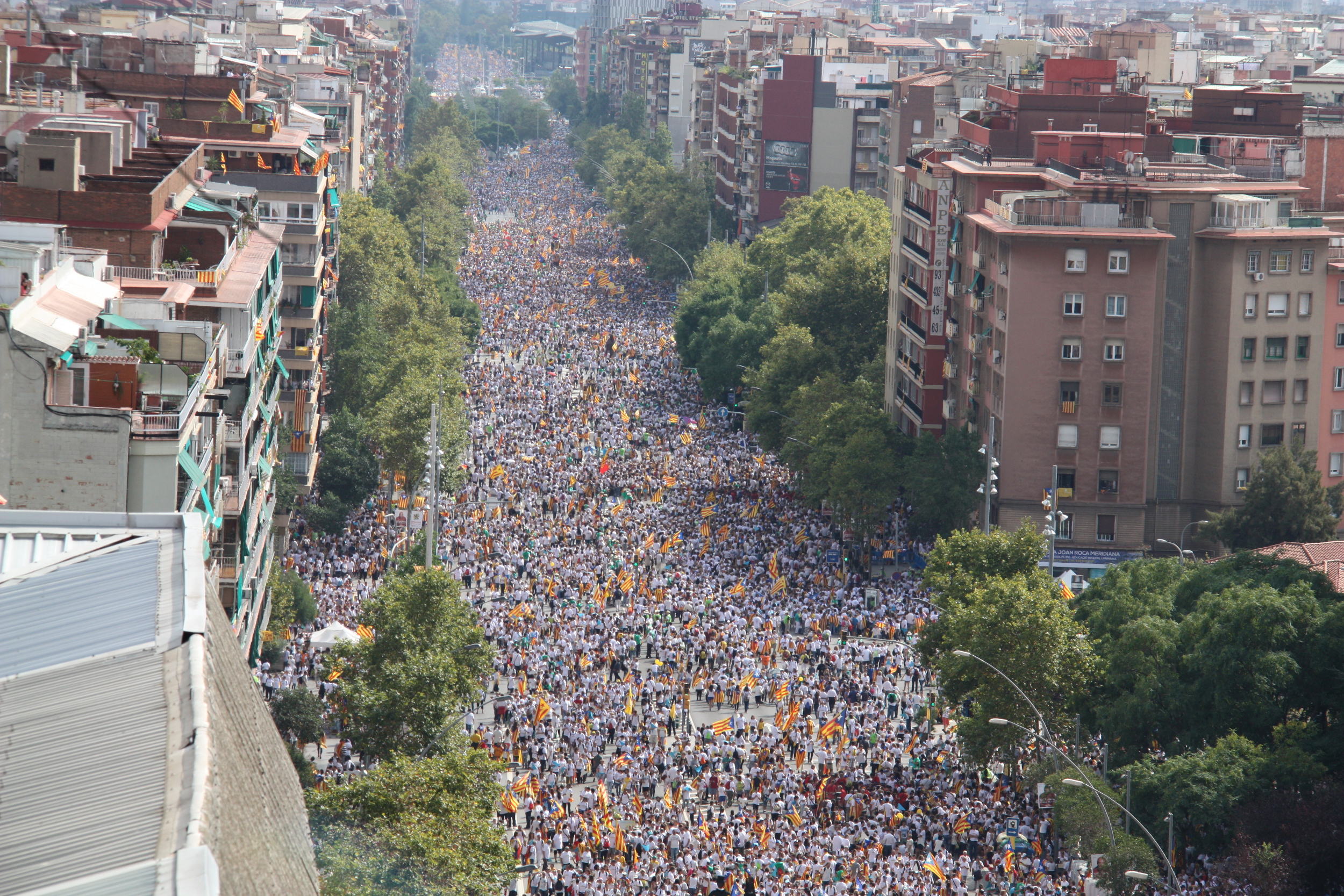Massive turnout at Catalan independence demonstration
Yes supporters in Catalonia hit the streets Friday in a new historic rally organised two weeks before a crucial election that is being framed as a ‘de facto’ referendum on independence. The ‘Via Lliure cap a la República Catalana’ (Gateway to the Catalan Republic) covered a 5.2-kilometre stretch of one of Barcelona’s main avenues, the Meridiana. People poured into the city waving the independence flag, known in Catalan as ‘estelada’. Today’s rally is the fourth huge demonstration in support of independence that Catalans have organised on 11 September, their National Day. In previous years, up to 1.5 million people demonstrated in the streets.

Barcelona (CNA).- Yes supporters in Catalonia hit the streets Friday in a new historic rally organised two weeks before a crucial election that is being framed as a ‘de facto’ referendum on independence. The ‘Via Lliure cap a la República Catalana’ (Gateway to the Catalan Republic) covered a 5.2-kilometre stretch of one of Barcelona’s main avenues, the Meridiana. People poured into the city waving the independence flag, known in Catalan as ‘estelada’. Today’s rally is the fourth huge demonstration in support of independence that Catalans have organised on 11 September, their National Day. In previous years, up to 1.5 million people demonstrated in the streets.
Meridiana Avenue runs from the ‘Parc de la Ciutadella’, where the Catalan Parliament is located, to the outskirts of the city. Therefore, the rally symbolically links the Parliament, where Catalonia’s sovereignty lays, with the streets of Barcelona and the rest of the country. The route was divided into 135 stretches, symbolising the Catalan Parliament’s total number of MPs.
The 5.2 km-long rally included the use of 10 different colours, one for each of the 10 key values that an independent Catalonia should guarantee: yellow for democracy, blue for regional balance, red for solidarity, sky blue for openness to the world, green for diversity, dark green for sustainability, purple for equality, brown for welfare and social justice, pink for innovation and orange for culture and education.
The demonstration thus created a massive mosaic in the shape of a big pointer leading to the Catalan Parliament, the institution that, in case of a Yes victory on the 27th of September, would start the process of declaring independence.
The ‘Via Lliure cap a la República Catalana’ was organised by the grassroots pro-independence Catalan National Assembly (ANC) and the non-profit association promoting Catalan language and culture Òmnium Cultural. The demonstration is not linked to any political party, and in fact members from different political traditions took part. “The rally is not partisan”, said Josep Rull of the Catalan President Artur Mas’ CDC party. “The demonstration is open to all Catalans”, he added. The left-wing radical independence party, CUP, which is not running in the election with ‘Junts pel Sí’, also took part in the rally.
However, critics suggest that the rally was very much linked to the main pro-independence coalition ‘Junts pel Sí’ (Together for Yes). Lluís Rabell, candidate for ‘Catalans Yes We Can’, a left-wing coalition that includes Podemos and which does not favour independence, said that some felt that this year’s rally was “propaganda” in favour of Mas and his party. “A lot of people like me, which have always fought for Catalonia’s rights, feel uncomfortable with today’s rally”, he said.
A special demonstration
This year’s demonstration on Catalonia’s National Day happens to be on the same day that the electoral campaign for the upcoming election starts. The poll is considered by Yes supporters as a ‘de facto’ referendum on independence. Catalan President Artur Mas said on Friday that he would rather count “votes instead of seats” but “all attempts to organise a referendum have been blocked” by the Spanish governments. In a press conference with international media, Mas said that the election is the “only legal option” that he had left to count how many people are in favour of independence.
Mas is running in the election with the pro-independence unitary list ‘Junts pel Sí’ (Together for Yes). Led by former Green MEP Raül Romeva, the list gathers together Liberals, Social-Democrats, Greens, Christian-Democrats, Socialists and civil society organisations. Mas comes fourth on the list and left-wing pro-independence ERC leader Oriol Junqueras is fifth. “If we win, if we have a majority of MPs, we will be open to negotiate with Madrid, Brussels and all European capitals in order to get an agreement. We’ll have a positive attitude”, Artur Mas said.
30 international figures attend the events on Catalonia’s National Day
Thirty people from different countries were invited by Òmnium Cultural, the main civil society orgnisation promoting Catalan culture and language, to witness the independence movement at the Meridiana Avenue in Barcelona on the 11th of September 2015. Scottish writer, Irvine Welsh, French-American activist, Susan George, Germany’s foreign affairs advisor, Kai Olaf Lang, and professors such as Michael Keating, Michel Seymour, Bard Fassbender, David Farell and Rogers Brubaker are among those invited by the sovereignty association.
The aim of Òmnium Cultural was to “internationalise” the process of Catalan sovereignty and explain the arguments in favour of independence to international figures from different fields, including those from the world of journalism.
Guests such as Michael Seymour, Professor of Philosophy at the Université de Montréal, Michael Keating, Director of the Centre on Constitutional Change at the University of Aberdeen and Roger Brubaker, professor of Sociology at the University of California were also invited because of their academic status and specialty in topics such as nationalism, secessionism and constitutional law which are essential matters in the Catalonia debate.